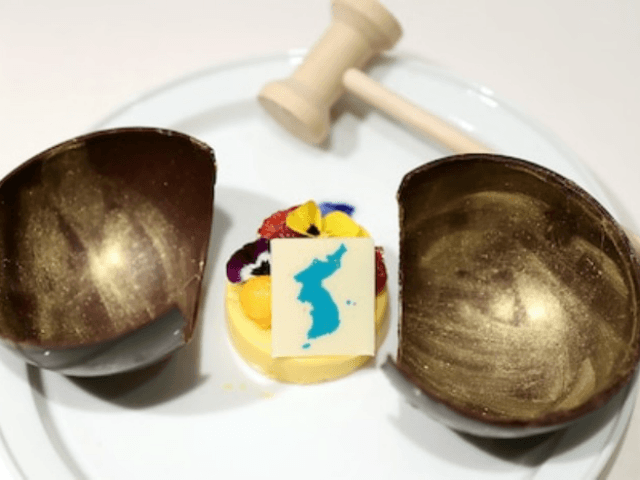The government of Japan lodged a formal protest on Wednesday against the mango mousse tarts to be served at Friday’s summit between South Korean President Moon Jae-in and North Korean dictator Kim Jong-un.
The Japanese do not appear to have a problem with mango mousse per se; their complaint is that the tasty treats are decorated with a map of the Korean Peninsula that includes a contested island claimed by Japan.
The islands in question—actually a pair of rather forbidding rocky islets located close together—are called “Dokdo” by the South Koreans and “Takeshima” by the Japanese. Some third parties prefer to use the more neutral name “Liancourt Rocks” to avoid taking sides in the territorial dispute. North Korea claims the islands as “sacred territory,” too, but relatively little attention is paid to their claim.
The Korean name is more widely used because the South Koreans have physical control of the territory, with a few dozen security officers stationed there. One of the rougher patches in South Korea-Japan relations occurred in 2011 when a group of Japanese lawmakers attempted to visit the island and were turned away by South Korean forces.
Ownership has been a point of contention between South Korea and Japan for the past sixty years. Both nations have historic claims to the islands dating back hundreds of years, plus formal legal claims from the early 20th Century.
South Korea finds the Japanese claim infuriating because it is linked to Japan’s imperialist colonization of Korean territory. Imperial Japan was eliminated by World War II but, unfortunately, the conclusion of the war did not legally settle the fate of Dokdo/Takeshima. The Japanese claimed the islands were granted to them by the Allied high command, but they are not specifically mentioned in the peace treaty that concluded the war.
The Dokdo islets are the last unsettled Japanese-Korean territorial dispute from World War II. Both governments adamantly refuse to relinquish their claims, both continue to list the islands as part of their provincial administrations. Dokdo lies roughly halfway between South Korea and Japan. It covers less than 50 acres of land altogether, much of it uninhabitable. Very few people actually live there. As the Conde Nast Traveler explained last year:
The only two civilian residents of the island are a Korean octopus fisherman and his wife. But almost fifty government personnel live there as well, because the South Korean Coast Guard has administered the islands since 1954. In recent years, “Dokdo” has been a big point of pride in the Korean media, inspiring patriotic propaganda and almost 100,000 tourist visits a year. Tourists hop off the ferry, wave flags, and take photos for twenty minutes, and then head back. The Japanese government objects to these visits, since to them visiting “Takeshima” is an international vacation.
There are excellent fishing grounds around the islands, and some mineral and gas exploration has been conducted, but the territorial dispute is primarily a matter of stubborn national pride.
South Korea and Japan essentially take turns annoying each other over the islands. It is usually a matter of theatrics, like Japan holding a “Takeshima Day” celebration, but in 2006 there was a gunboat standoff that the U.S. State Department feared could escalate into a shooting war between South Korea and Japan.
Korea Joongang Daily wearily described the dispute in 2008 as a “political circus” that travels back and forth between Tokyo and Seoul. The circus has its tents pitched in Seoul at the moment. South Korea began displaying a “unification flag” that pointedly included Dokdo as part of reunited Korea in exhibition matches leading up to the Pyeongchang Winter Olympics this year. It might sound like a nitpicky detail, but the islands are very noticeable on the flag. From Japan’s perspective, it might as well be an embroidered middle finger thrust at Tokyo.
The Japanese were outraged when the flag was hoisted at Olympic exhibition games, which provides important context for their protest of mango mousse dessert treats decorated with the same image to be served at the Moon-Kim summit. Chief Cabinet Secretary Yoshihide Suga declared the unification flag “extremely regrettable,” which is exactly what the Ministry of Foreign Affairs said about the desserts on Wednesday. The chairs surrounding the summit table are reportedly decorated with the same image, prompting another complaint from Japan.
The South Korean government stopped using the reunification flag after Japan’s complaint, although care was taken to give the impression they were responding to International Olympic Committee directives against politicizing the event rather than bowing to pressure from Tokyo. The Japanese are unsurprisingly miffed that the flag is reappearing on a dessert that will be served at a historic summit that might begin the process of formally ending the Korean War. Also, you just know Kim Jong-un will ask for a second helping.

COMMENTS
Please let us know if you're having issues with commenting.